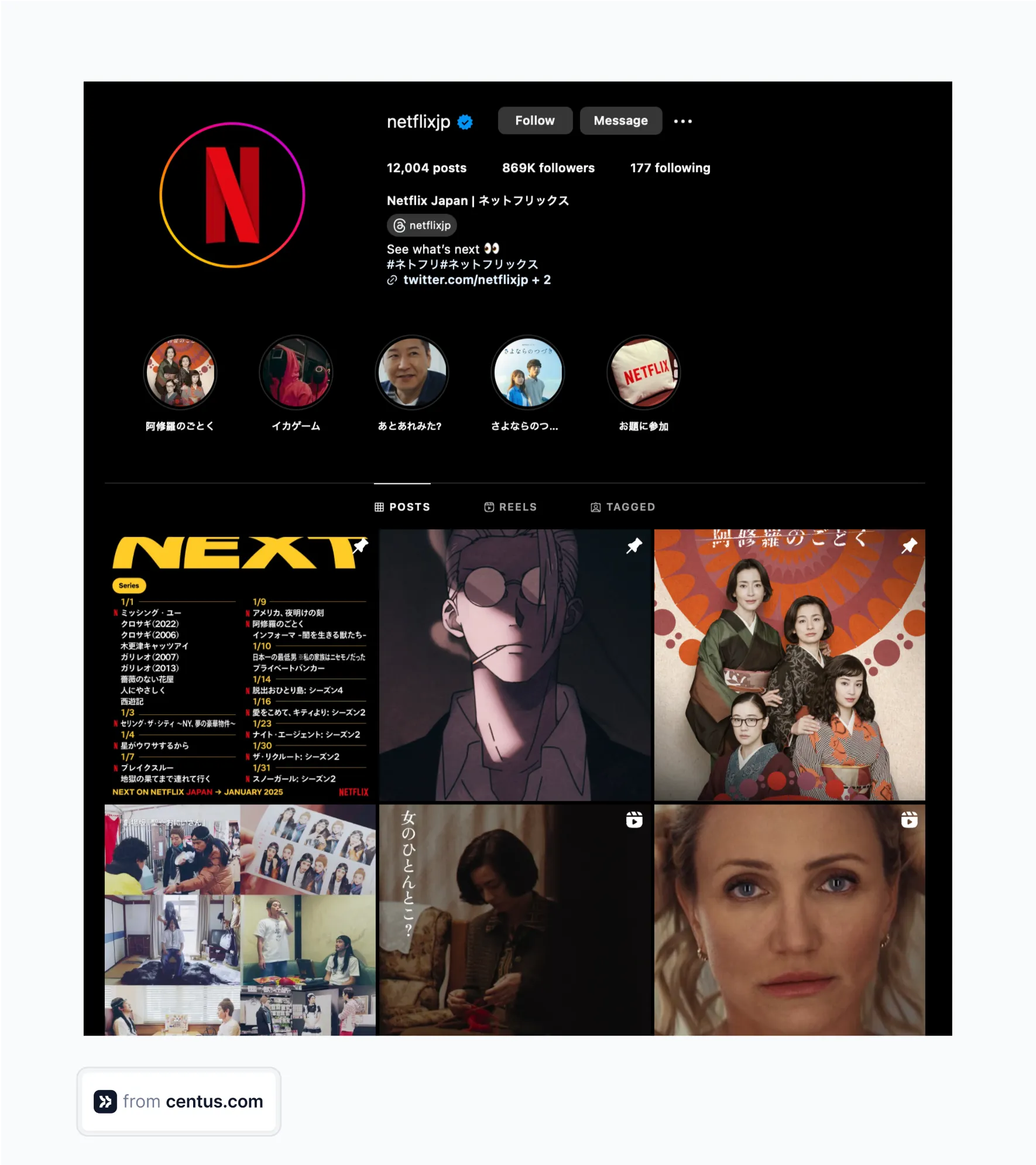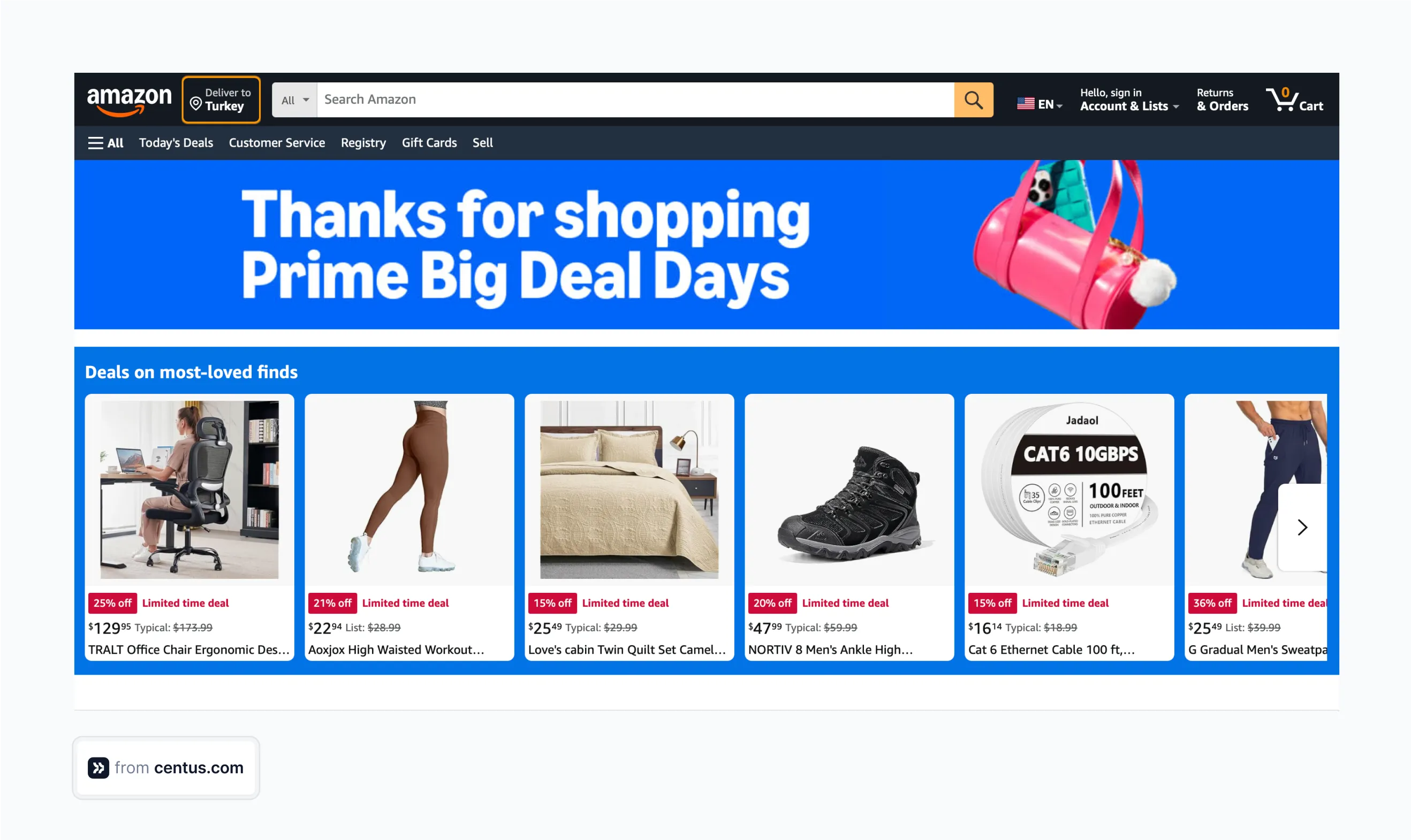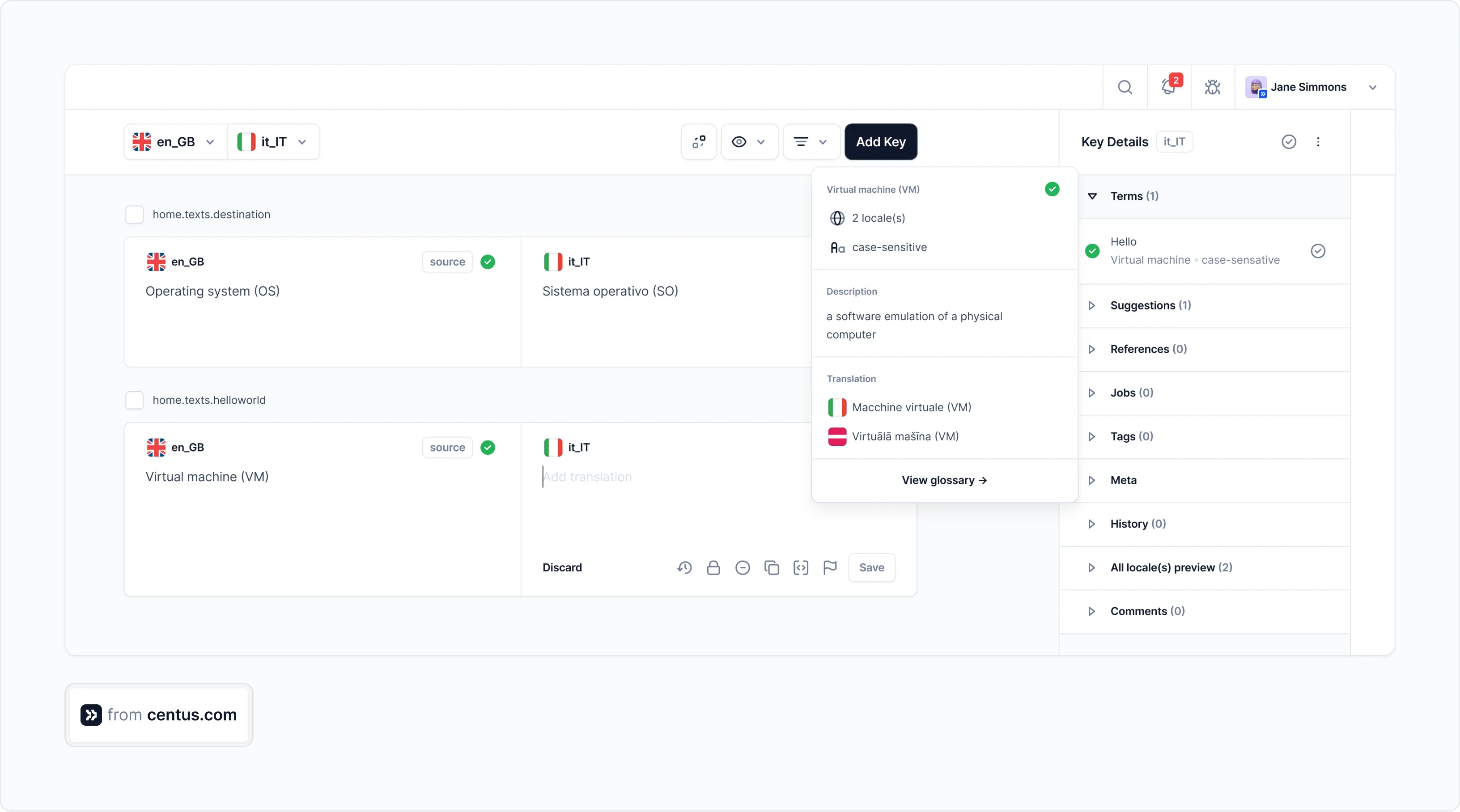According to a 2020 survey by CSA Research, the decision to not localize your content could cost you up to 40% of the target market – customers who simply won’t buy from websites that aren’t in their local language.
Here’s the good news: the global market is overflowing with potential. The biggest SaaS companies, such as HubSpot, Slack, and Twilio, make almost half of their revenue from international audiences. No surprise that the top 10 SaaS giants support an average of 17 languages.

Do you think it’s only about translation? Not quite. Customers now use browser extensions to translate your website. What matters is how your global content strategy speaks to local audiences.
What is global content marketing?
Global content marketing is a strategy that uses content to promote a business and its offerings to an international audience.
-
As a process, content marketing involves creating, managing, localizing, and distributing content to international customers in various formats, including blog posts, white papers, videos, and social media posts.
-
As a marketing strategy, global content marketing aims to deliver a consistent but locally relevant brand message that resonates with the target audience. The biggest challenge? Local responsiveness. Successful global content marketing means understanding and addressing cultural, linguistic, and behavioral differences across regions.
Note: Boosting sales may be one of the global content marketing goals, but not necessarily the only one. Content can educate, engage, attract, build relationships, and raise brand awareness – all of which are just as valuable when building a global presence.
Global content marketing vs international content marketing
Global content marketing is often used as a catch-all term for any strategy targeting international markets. However, there are two approaches to content globalization depending on your expansion strategy.
📘 Relevant reading: 4 global expansion strategies
Global content marketing
Global content marketing delivers universal content across international markets with minimal changes. This approach relies on a centralized strategy driven by the home country or headquarters, meaning businesses don’t need to set up local marketing teams in every country they operate.
Just like the global expansion strategy, global marketing aims for a one-size-fits-all approach, emphasizing standardization – whether it’s the product, messaging, or teams.
Take Apple as an example. Whether you’re browsing their website in the US or Turkey, you’ll see the same visuals and messaging about the iPhone 16 Pro.
Let’s take a look at the American version of Apple’s website:

Now compare it to its Turkish version:

As you can see, the only difference in the two examples above is language.
International content marketing
International content marketing, on the other hand, focuses on tailoring strategies to specific markets and is often curated by local marketing teams to align more closely with regional preferences and consumer behavior. Such content is highly specific, and so are the offerings it promotes.
Businesses choosing international strategy typically adapt their product or services to better meet local needs.
📘 Relevant reading: International expansion strategy
For example, Netflix’s Instagram accounts in Spain and Japan look completely different. Here’s what Netflix’s Spanish Instagram account:

And here’s the company’s Japanese Instagram account:

See? Everything – from the featured shows and visuals to the messaging – is designed to resonate with each market’s preferences.
Different channels for different approaches
Messaging isn’t the only thing that changes; how content is distributed in global and international content marketing also varies.
-
Global marketing sticks to channels with global reach (like social media platforms including LinkedIn, Facebook, or Instagram). For this reason, companies following this approach usually maintain one account across different platforms to deliver consistent messaging globally.
-
International marketing relies on local channels. Think TV commercials, region-specific social media platforms, or collaborations with local influencers and celebrities. Companies often create separate accounts for each market to deliver custom messages that connect with their audience.
5 steps for the successful global content strategy
Global content marketing has the power to connect you with millions of potential customers worldwide, and what you aim for is success.
Here’s how to achieve it👇
- 🎯 Set the right goals and align them with business priorities
- 🕵🏼♂️ Understand your audience (dive into market and audience research)
- 🥇 Produce high-quality content (and have the expertise to do so)
- 🧑💻 Build a high-performing team
- 📈 Effectively measure your success
Everything should, of course, be neatly wrapped up in a documented global content strategy. Just as 65% of the most successful marketers already do.
Now, let’s break down these steps:
Step 1. Set goals and align them with your organization’s objectives
Setting content globalization goals isn’t always straightforward. Headquarters (HQ) and regional teams often have different priorities. For example, HQ might focus on launching a new product, while a regional team wants to emphasize high-demand products already popular in their market. Similarly, a local team may need a bigger budget than HQ is ready to allocate or prefer local media platforms, while HQ wants to stick to Google Ads and LinkedIn.
Be ready to tackle these misalignments and communicate regional differences to HQ. A decentralized model can offer local teams more flexibility to set goals that resonate with their audience, especially in markets requiring high local responsiveness and tailored content.
HQ’s goals and possibilities determine the level of centralization (or decentralization), allocated resources, country priorities, and how content is created, published and adapted for each market.
When setting goals, keep in mind that performance needs to be measured differently across regions (more on this in Step 5). You can’t simply copy KPIs from one market and apply them to another due to cultural differences and unique behavioral patterns.
Example: In Northern Europe, customers prefer to make decisions independently, leading to more website visits and longer customer journeys. In the Middle East, customers value face-to-face interactions, shortening the digital journey.
In the US, limited-time offers and other aggressive discounts are standard marketing tactics.

However, in Japan, such strategies can devalue brand reputation. For this reason, Amazon had to adapt its Prime Day, an annual event featuring aggressive discounts, for Japanese customers. Instead of discounts, Amazon Japan emphasizes "added bonuses," such as free shipping or bonus points for Prime members.

Now, the Japanese version of Amazon features free delivery and unlimited access to movies, music, and books.
Step 2. Understand your audience
Easy to say, but hard to achieve even for giants like Walmart (exited Germany in 2006), Airbnb (left China in 2022), and Starbucks (Australia failure).
Example: Starbucks entered the Australian market in 2000 but had to close 61 out of 87 stores just 8 years later, mainly due to the failure to adapt to the local coffee culture. After 23 years and over $140 million in losses, Starbucks finally announced its first profit in November 2023.
Your content should resonate with the local audience, reflecting their demographics, shopping behaviors, and pain points. But that’s not all. You need to understand local values, traditions, holidays (and significant dates for timely content delivery), politics, and even the nuances of local languages.
Example: Using local slang and dialects can make your content more relatable. Australians might prefer “breakkie” for breakfast, while in the U.S., it’s “soccer,” not “football.”
I recommend focusing on buyer personas. Craft them in detail for each new market you target. Standardized global personas may work if you have unified offerings across markets and a well-established brand. But if your brand is not yet well-recognized and your offerings require local adjustments, creating unique customer profiles for each region makes more sense.
While it’s tempting to assume that customers in the U.S. and Italy are largely the same, you can miss out on unique traits that could be pivotal for your content marketing strategy. Along with age, gender, and language, there are so many other factors that you should consider:
-
Brand familiarity. How familiar are your brand and your offerings?
-
Market maturity level. For example, digital ecosystems in developed and innovation-driven regions differ from those in emerging and developing markets.
-
Income level. What is the average income of your ideal customer?
-
Online activity. What are the commonly used devices, social media platforms, and online activity times?
-
Cultural differences. Are there cultural differences that can affect your messaging and angle?
Pro tip: Don’t rely solely on Google and online tools for market research. Dive deeper by organizing local focus groups, hiring local consultants, and running surveys to gather more insights.
Step 3. Produce high-quality content
When you know your audience, the next step is to evaluate your current content.
-
List all your content across formats, languages, and platforms.
-
Prioritize content that drives the most revenue directly, such as landing pages, pricing pages, and ad campaigns.
-
Focus on key customer-facing content with indirect impact, like product documentation, tutorial videos, and sales materials—these may not generate leads directly but can be crucial in decision-making. To cut costs and streamline production, you can loalize media assets using AI prompts for design.
-
Plan for locale-specific content tailored to regional needs, such as custom landing pages addressing local pain points, targeted ads, or adapting content formats (e.g., video instead of text).
Self-assessment helps you decide whether to localize existing content or create new material from scratch. A hybrid approach often works best. You can localize your top-performing content while creating new, region-specific materials.
📘 Relevant reading: Marketing localization guide
Optimize content for international SEO
You also need to optimize content for international SEO to help it rank in a new region.
Don't rely solely on broad-term keywords or direct translations—they may not reflect what people are actually searching for. Instead, analyze region-specific keywords and search patterns to achieve better results.
Pro tip: For best results, ensure cooperation between your translators and SEO experts. You can organize it right in the localization management platform, Centus, where they can create automatic translations and then optimize them for SEO collaboratively.

Note that international SEO goes beyond keywords:
-
Hreflang tags. Your website pages should include hreflang tags to help search engines match content to the correct language and locale.
-
Local link building. You need additional investments in local bloggers, media, and influencers to improve content visibility and gain backlinks.
📘 Relevant reading: A guide to international SEO
Analyze competitors
No need to reinvent the wheel. Learn from your competitors!
Analyze their content, messaging, distribution channels, and target keywords. For example, if your competitors prioritize videos over long-form formats like blog posts, you might also want to focus on videos, which leads us to the next point.
Select the right distribution channels
Even the best content can underperform if delivered through the wrong channel. The popularity of social platforms varies by region, as do local search engines, media platforms, forums, and communities.
Example: LinkedIn is the world’s most famous business-focused social platform, but German professionals prefer local XING. In South Korea, the NAVER search engine is dominant over Google.
You need to branch out strategically and identify the most relevant channels to reach local audiences. Distribution channels can also determine the dominant content format.
Example: The popularity of Instagram, Facebook, and Twitter makes infographic and video formats more popular in the U.S., while Chinese platforms WeChat and Weibo encourage businesses to publish more long-form posts.
Create global brand guidelines
Brand dilution is a real problem when you go global, as it’s harder to maintain consistent messaging across regions. You need unified brand guidelines for local content creators and marketing teams to ensure your brand’s voice, tone, colors, and imagery style are cohesive.
📘 Relevant reading: Brand localization guide
Step 4. Build an effective marketing team
Depending on your overall global content strategy as well as HQ’s goals and budget, you can:
-
Hire a local team. Ideal for markets that need high levels of local responsiveness. However, building a local team requires significant time, money, and proper management.
-
Partner with local freelancers and agencies. Collaborating with local experts is often faster and more cost-effective than setting up a team. However, you may lack control over your brand messaging and content consistency.
-
Use HQ’s content strategy and translate the existing content. A centralized approach makes your content consistent but less adaptable to local preferences. You can either use machine translation or work with human translators and agencies.
I recommend choosing the hybrid approach and only using raw machine translation for low-visibility, low-impact content like internal documentation, chat messages, or product reviews. High-stakes content like homepages, paid ads, or legal documentation require human translation, adaptation, or even transcreation.
Example: KFC learned this lesson the hard way when the direct translation of their “Finger-Lickin’ Good” slogan turned into “Eat Your Fingers Off” in Chinese. Funny? Yes. Credible? Definitely not.
If you’ve ever managed content, you know how quickly things can spiral out of control, especially when you manage content across multiple markets and languages.
For example, here is the workflow of our content localization at Centus. Remove the translation and several review stages, and you’ll have the workflow for content creation. Seems like a breeze, right? 😉

The solution: document and standardize everything, from workflows to templates. No matter how independent your local content team is, they need to follow the established process. Otherwise, content management can become a game of whack-a-mole – constant chaos and no clear direction.
📘 Relevant reading: All you need to know about localization management
Step 5. Measure success
Metrics play a vital role in assessing how well your global content marketing efforts are faring. Yet, half of marketers fail to measure content performance effectively.
From Step 1, we know that 👇
-
Performance metrics should be tailored to each market depending on the region-specific goals.
-
Performance metrics and objectives should support the overall strategy of HQ, even when local priorities are different.
Here are a few examples of what KPIs you can track for your content:
-
Engagement. Likes, shares, comments, average time on the page, and bounce rate can give you insight into how actively users interact with your content.
-
Conversion. Click-through rates (CTR), form submissions, and sign-ups help you understand the effectiveness of your content in driving specific actions.
-
Reach. To access the visibility of your content, you can track keyword ranking, unique page visitors, and impressions (the number of times your content was displayed).
-
Retention. Return visitor rate (how many visitors return to your content) and bounce rate indicate how “sticky” your content is and whether users come back for more.
-
User sentiment. Brand mentions, user comments and reviews, feedback forms, and sentiment scores derived by tools like MonkeyLearn and Contentsquare can give you a better understanding of how audiences perceive your brand.
-
Return on Investment (ROI). ROI gives insights into which regions and content types are the most profitable. However, 56% of marketers struggle to attribute ROI to content efforts. To calculate ROI effectively, define your content goals (lead generation, retention, awareness, etc.), decide on the attribution model, and map content performance to the customer journey.
📘 Relevant reading: How to measure localization ROI
You can track most metrics I mentioned above using Google Analytics, Google Tag Manager, SEO software suits like Ahrefs and Semrush, and behavior analytics tools like Hotjar and Crazy Egg.
Best global content marketing tactics for 2025
Now, the bonus part 🥳
If you want to take your global content marketing to the next level, these 3 tactics are a great place to start.
1. Create customer-centric content
Solve customers’ problems with your content. While traditional SEO and keyword optimization have their place, they don’t always align with customers’ true pain points and buying intent.
Your strategy should start with a deep understanding of your customers. By focusing on their needs, you can create content that solves real problems—setting you apart from competitors who prioritize traffic over value.
2. Ditch the dry facts – tell a story
The traditional "awareness-to-action" model gives way to situational content marketing, where tailored, context-specific content meets consumers at different stages of their journey. At the same time, keyword-based queries rapidly evolve into conversational AI searches.
To stay competitive in this shifting landscape, you need to emphasize brand authenticity, build expertise and authority, focus on storytelling, and create content that feels human – key worldwide marketing trends for 2025, according to CMI.
Deanna Ransom, SVP of Revenue at BetterBot, captures this perfectly:
💬 “If marketers are signaling a virtuous purpose that doesn’t ring true, young people can pick up on that. It shows a lack of empathy. We all know when someone is talking at us versus when someone is talking with us, and those nuances are so important.”
Here are a few examples of what you can implement now:
-
Turn boring “challenge-solution” case studies into inspiring success stories that deliver not only dry facts but also your brand values.
-
Use a more conversational tone in your writing to engage readers.
-
Be contextually relevant by tailoring content to specific pain points (instead of one guide on using AI for research, you can create separate guides for marketers and entrepreneurs).
-
Highlight brand personality to build social identity and emotional connections. Share stories from your own brand, rather than relying on examples from well-known companies.
3. Invest in video content

If you’re not creating video content yet, now’s the time 🎯
- According to Hubspot’s 2023 report, video has been the most frequently created content type for four years running.
- Wyzowl’s research shows that over 80% of people bought or downloaded software (or apps) after watching a video about them.
- In January 2025 alone, YouTube attracted 3.6 billion organic visitors worldwide – 8 times Google’s monthly organic traffic!
You can experiment with live videos, Q&A sessions, product demos, video testimonials, and podcasts. You can also turn your top-performing blog posts into short, shareable video snippets for social media – the opportunities are endless.
Parting thoughts
A successful global content marketing strategy isn’t just about translation – it’s about connecting with audiences in a way that feels authentic and relevant to their unique contexts.
While your marketing team works its magic, Centus can help ensure seamless localization to keep your brand message consistent and impactful across all markets. Try Centus now!
Or dive deeper into what content localization is all about.
Get the week's best content!
By subscribing, you are agreeing to have your personal information managed in accordance with the terms of Centus Privacy Policy ->
Keep learning
7 min. read
What is Global Localization: Principles & Strategy
9 min. read
Top 10 International Marketing Principles
11 min. read
How to Build a Localization Strategy and Do it Right
6 min. read
Internationalization and Globalization: What’s the Difference Between?

13 min. read
Building a Multidomestic Strategy with Examples

9 min. read